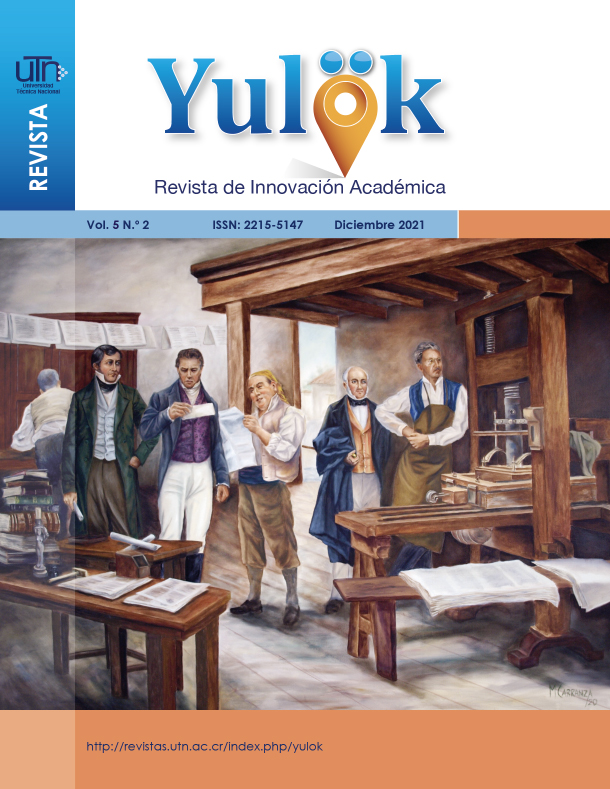The female subject in the Salvadoran modernist short story: a reading of its construction and cultural implications
Main Article Content
Abstract
The article analyzes the representation of women in an innovative context such as that of the Salvadoran modernist short narrative to study the construction of female characters, their corporeal-ideological configuration, and the articulation of female social roles in the texts. It is determined that the model of woman constructed in the stories is analogous to that of modernism at the Hispanic American level, always from the censoring eye of the male subject. The woman appears as a voiceless individual, ideologically conceived as an object that can be killed and possessed by her male partner. Regarding social roles, they are configured as wives or mothers, with no place in public space. All this shows the generation and survival of a culture of violence against the female subject due to the conjuncture of machismo and the patriarchal structure.
Article Details

This work is licensed under a Creative Commons Attribution-NonCommercial-ShareAlike 4.0 International License.
Todos los artículos publicados están protegidos con la licencia Creative Commons Atribución-NoComercial-CompartirIgual 4.0 Internacional
![]()
How to Cite
References
Baldovinos Roque, R. (2009). Para una filosofía del hecho menudo: Ambrogi y la crónica modernista. En L. Mariela Castro, R. O. López Salazar, L. Mariela Castro, & R. O. López Salazar (Edits.), Antología del pensamiento crítico salvadoreño contemporáneo (pp. 239-266). https://doi.org/10.2307/j.ctvfjd0vt.12
Camacho, J. (2001). El cirujano y la enferma: la representación de la mujer en la literatura modernista. Revista Canadiense de Estudios Hispánicos, 26(1/2), 351-360. https://doi.org/10.2307/27763773
Camacho Delgado, J. (2006). Del fragilus sexus a la rebellio carnis. La invención de la mujer fatal en la literatura de fin de siglo. Cuadernos De Literatura, 10(20), 27-43.
Fuentes, I. (1895). Zaíra. En Coordinación Educativa y Cultural Centroamericana, Antología Literaria Centroamericana: el modernismo (pp. 191-193). Imprenta Nacional.
García Sánchez, J. (2011). El retrato modernista ecuatoriano: simbolismo, mujer y exotismo en Abelardo (1895), de Eudófilo Álvarez. Kipus: Revista Andina De Letras y Estudios Culturales, (29), 129-152.
Imendia, C. (1903). Tep-Ta Leyenda indiana. En Coordinación Educativa y Cultural Centroamericana, Antología Literaria Centroamericana: el modernismo (pp. 161-163). Imprenta Nacional.
Lagos, y L. (1895). La loca. En Coordinación Educativa y Cultural Centroamericana, Antología Literaria Centroamericana: el modernismo (pp. 179-180). Imprenta Nacional.
Marticorena, E. (2017). Mujeres fatales y desviados: nuevos deseos al asalto en el desfiladero de la literatura modernista. Lexis, 41(1), 5-43. https://doi.org/10.18800/lexis.201701.001
Pérez Abreu, C. (2005). La mujer como enfermedad y muerte en el proyecto modernista: Notas para un estudio. Espectáculo Revista de Estudios Literarios, (30), 1-10.
Quesada Soto, Á. (1984). Reflexiones acerca de la polémica sobre nacionalismo literario. Revista De Filología Y Lingüística De La Universidad De Costa Rica, 10(1), 3-14. https://doi.org/10.15517/rfl.v10i1.16171
Saporta Sternbach, N. (2015). La muerte de una mujer bella: Modernismo, la mujer escritora y la imaginación pornográfica. Badebec, 5(9), 356-384.
Segas, L. (2015). Variaciones en la menor: el retrato femenino en la narrativa modernista venezolana. Creneida, (3), 63-89. https://doi.org/10.21071/calh.v3i.5300

